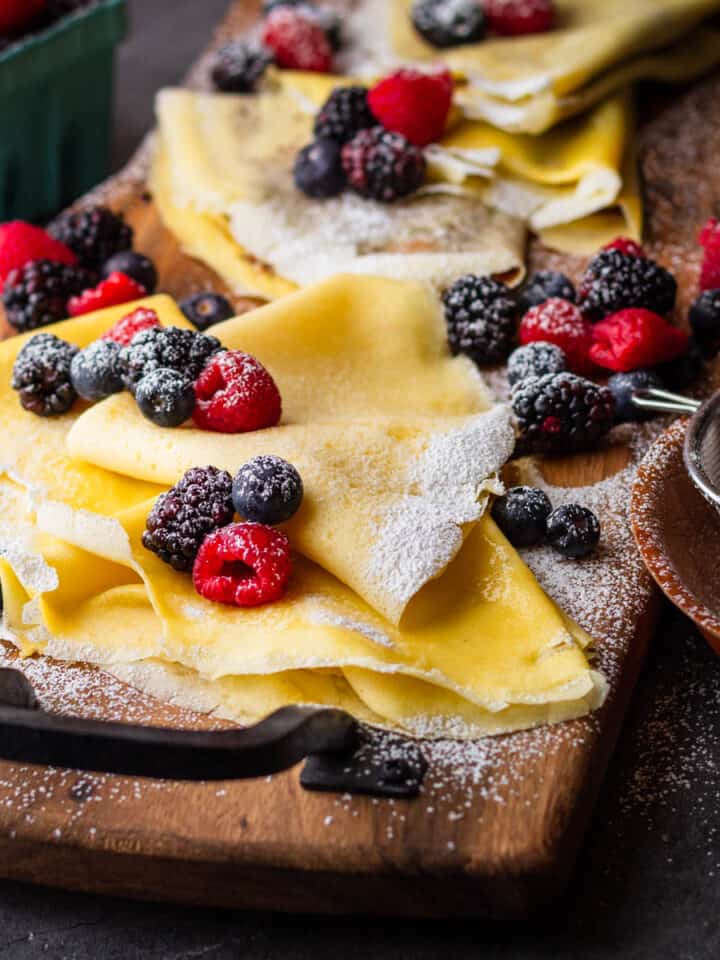
Whether you know them as eggs in purgatory or Italian baked eggs, these saucy poached eggs make for a satisfying, savory breakfast. Although this dish is a restaurant brunch staple, it’s also easy to make at home!

The history of Italy and the history of the Catholic Church are closely connected, so the Italian name for these baked eggs—uova in purgatorio—probably doesn’t need much explanation! Yes, the poached eggs are the “souls” stuck in purgatory—and, in this case, purgatory is a fiery, garlicky tomato sauce.
As an egg dish, Italian baked eggs are right at home on the breakfast table and a fantastic savory option for a brunch with family and friends. The flavors in the recipe also make it fitting as a breakfast-for-dinner, especially when served with some crusty Italian bread for soaking up all that sauce—and runny yolks too, if that’s how you like your eggs!
This is one of those dishes that’s much easier to make than you might expect; a simple list of ingredients (most of which you probably have on hand!) is all you need to create big, bold Italian flavor in this egg dish.
Jump to:
🍳 Eggs in purgatory vs. Shakshuka
This dish is sometimes called Italian shakshuka. The difference between Italian baked eggs and North African shakshuka is all in that tomato sauce—shakshuka typically includes peppers, onions, and earthy spices like cumin and paprika, while the Italian version has more classic Italian flavors like basil and garlic.
🥚 Ingredient notes

- Eggs – Whole eggs are cracked into the rich tomato sauce, although if you’re nervous about your egg cracking skills, you can crack them into a small bowl first and then tip them right into the pan. The sauce poaches the eggs to your desired doneness; plan for 1 to 2 eggs per person.
- Sauce – Use whole peeled tomatoes; I prefer San Marzano certified, which have a sweeter flavor and fewer seeds. Fresh basil and garlic add delicious flavor to the sauce, while a pinch of red pepper flakes brings some heat to the table. If you’re in a hurry, you can use leftover Italian-style marinara sauce for super easy Italian baked eggs!
📋 Substitutions and variations
- Cheese – Add dollops of ricotta cheese around eggs before baking for a little extra richness. When you stir it into the sauce before eating, the ricotta creates a fabulous creaminess. (Learn more about Italian cheeses.)
- Meat – Brown ground Italian sausage with the garlic to make a meaty sauce.
- Veggies – Add sautéed fresh vegetables like mushrooms or spinach with the garlic to make this egg dinner recipe a well-rounded meal.
- Spice – Adjust the amount of crushed red pepper flakes to your liking or eliminate for those that are sensitive to spice.
🔪 Step by step instructions
Preheat your oven to 400˚F and start heating a cast iron skillet on the stovetop over medium heat.
Add olive oil to coat the bottom of the pan and then stir in the garlic and crushed red pepper flakes. Cook until the garlic is fragrant and just beginning to turn golden.
Carefully add the whole peeled tomatoes to the pan and use a wooden spoon to crush and break them up into smaller pieces.
Tear the basil leaves into smaller pieces and stir them into the sauce, along with half of the kosher salt and black pepper.

Reduce the heat to medium-low and let the sauce simmer for 5 minutes while continuing to break up the tomatoes.
Crack the eggs into the sauce one at a time, leaving some space between them so they don’t run together. Sprinkle the tops with the remaining salt and pepper to season the eggs.
Transfer the pan to the oven and bake for 7-9 minutes. You want the egg whites cooked through and the yolks cooked to your desired doneness.
Remove the pan from the oven and serve the Italian baked eggs immediately.

If you ever don't recognize a tool or skill that is mentioned, be sure to look it up in our Glossary of Cooking Terms and Definitions for more information.
⭐ Expert tips
- You'll want to use an oven-safe pan, like this 10" cast iron skillet, with enough room for all the eggs. If you don’t have a cast iron skillet, a stainless steel skillet that doesn’t have plastic or glass on the handle will also work; if in doubt, check the manual for your cookware.
- Break up the tomatoes as the sauce simmers. You can crush them into small pieces for a smoother sauce, or leave them chunky if you’d like more texture.
- Split the salt and pepper—use half in the sauce to add flavor and the other half on top of the eggs so the entire dish is seasoned.
- Bake until the egg whites are fully cooked and the yolks are done to your liking, whether that’s cooked through or a little bit runny.
- Add freshly grated Parmesan and basil before serving for the best finishing touch!
🍳 Alternative cooking methods
Stovetop - To finish cooking on the stovetop, simply cover the pan with a lid and lower the heat to medium-low.
Grill - To cook Italian baked eggs on the grill, start by preheating a cast iron skillet. Follow the directions for making the sauce, crack the eggs into it, and close the lid to finish cooking.
🥡 Storage suggestions
Eggs in purgatory will last for 3-4 days when stored in an airtight container in the refrigerator. You can reheat leftovers in the microwave or on the stovetop over medium-low heat.
🍳 More breakfast recipes
If you loved this easy Italian baked eggs recipe, check out these other breakfast recipes that I know you will love too!
- Fluffy Cheddar and Chive Biscuits
- Hash Brown Crust Quiche with Pancetta
- Lemon Dutch Baby with Fresh Blueberries
- Baked Italian Strata with Fontina
Recipe

Easy Italian Baked Eggs (Eggs in Purgatory)
Ingredients
- 2 Tablespoon extra virgin olive oil
- 3-4 cloves fresh garlic, minced (approximately 1 Tablespoon)
- pinch crushed red pepper flakes
- 28 ounces canned whole peeled tomatoes, San Marzano certified (if possible)
- 10-12 large fresh basil leaves, plus extra for garnish (if desired)
- 1 teaspoon kosher salt, divided use
- ½ teaspoon black pepper, divided use
- 6 large eggs
- parmesan cheese, freshly grated for serving
Instructions
- Preheat the oven to 400˚ and heat a 10" cast iron skillet over medium heat on the stovetop.
- Add the extra virgin olive oil to the pan and swirl it around to coat the bottom.
- Add in the fresh garlic and crushed red pepper flakes and saute for about 1 minute until the garlic is fragrant and just lightly browned.
- Carefully add the whole peeled tomatoes and gently break them up into smaller pieces using a spoon.
- Rip up the fresh basil leaves into smaller pieces and add them to the sauce, along with ½ teaspoon of kosher salt and ¼ teaspoon of black pepper.
- Stir to combine everything, reduce the heat to medium-low, and let the sauce simmer for 5 minutes while continuing to break up the tomatoes.
- Break the eggs into the sauce, leaving space around them, and then sprinkle the tops with the remaining ½ teaspoon of kosher salt and ¼ teaspoon of black pepper.
- Place the pan in the oven to cook for 7-9 minutes until the whites are completely cooked and the yolks are cooked to their desired consistency.
- Remove the pan from the oven and serve immediately, sprinkled with freshly grated parmesan cheese and extra fresh basil, if desired.
Notes
- Eggs - Plan for 1-2 eggs per person depending on what else is being served.
- Cheese - Small dollops of ricotta cheese can be added around the eggs for extra creaminess.
- Meat Sauce - Cook up ground Italian sausage with the garlic and red pepper flakes.
- Veggies - Saute sliced mushrooms or spinach with the garlic.
- Spicy - The amount of crushed red pepper flakes can be adjusted, as desired.
- Stove Top - Reduce the heat to medium-low after adding the eggs, cover with a lid, and cook until the whites are done and the yolks are the desired consistency.
- Grill - Preheat the cast iron skillet on the grill set to medium heat. Follow the directions for making the sauce and adding the eggs. Close the lid after the eggs are added and cook until the whites are done and the yolks are the desired consistency.
- Leftovers - Store in the refrigerator in an airtight container for 3-4 days. Reheat over medium-low heat on the stovetop or in the microwave.

 By
By 




Comments
No Comments